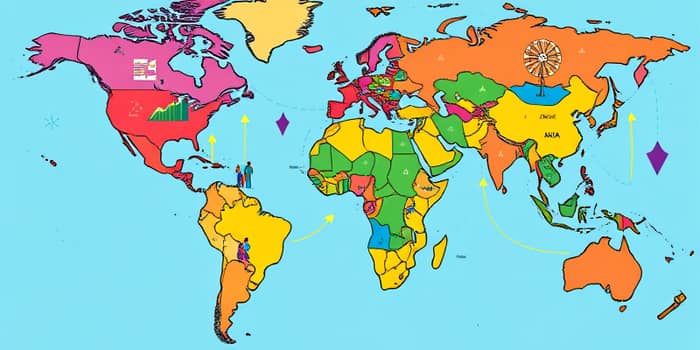
As the global economy navigates post-pandemic recovery and geopolitical shifts, investors and policymakers alike are turning their gaze beyond traditional strongholds. Emerging markets, long overshadowed by developed economies, are now stepping into the limelight as key drivers of global expansion. This article explores the latest data, thematic trends, and actionable insights to help you uncover where to find robust growth opportunities in 2025 and beyond.
By examining growth projections, investment flows, sectoral hotspots, and the challenges on the horizon, we aim to provide a comprehensive guide for professionals, entrepreneurs, and curious minds seeking to understand the evolving landscape of emerging economies.
In 2025, the collective GDP growth of emerging markets is forecast to reach approximately 3.7%, more than double the pace of most developed nations. Although this pace falls slightly below the decade average of around 4%, it still underscores the resilience and potential of these regions.
By contrast, developed markets are expected to expand at less than half that rate, highlighting a pivotal shift in economic gravity toward the Global South. The world average is estimated at 3.2%, placing emerging markets firmly at the forefront of global expansion.
These top performers are complemented by nations such as the Philippines and Vietnam, each projected at 6.1%, and other fast-growing economies like Uganda, Rwanda, and Mongolia. This diverse mix underscores the geographical breadth of opportunity awaiting investors.
Foreign direct investment remains a cornerstone for funding infrastructure, technology, and industrial projects. For 2025, the highest FDI confidence rankings are dominated by:
With Brazil overtaking India for the fourth spot, investor sentiment is clearly shifting as domestic economic performance and regulatory efficiency gain prominence in decision-making processes.
Across Southeast Asia, India, and Africa, the rapid expansion of mobile internet, e-commerce, and fintech is creating momentum for digital infrastructure development. Southeast Asia’s internet economy alone could reach $600 billion by 2030, catalyzing new consumer and business models.
Meanwhile, young populations drive consumption and innovation in India and much of Africa, fueling domestic markets and global export capacity. Favorable age demographics translate into a vibrant labor force and rising household incomes.
Supply chain realignments are also in full swing as companies seek nearshoring and supply chain diversification beyond China. Key beneficiaries include Vietnam, Bangladesh, Mexico, and North African nations, which are strategically positioned to absorb manufacturing relocations.
Finally, despite policy headwinds in some regions, there is sustained interest in clean and affordable energy solutions. Investments in renewables and sustainable technologies are increasing, laying groundwork for long-term economic and environmental benefits.
No investment landscape is without risk, and emerging markets face distinct challenges. Ongoing US-China trade tensions and new tariffs introduce volatility for exporters, although they also drive domestic stimulus and innovation, particularly in China. India’s robust internal demand and reform agenda offer some insulation from external shocks.
Inflation, too, remains higher than in developed markets. The average inflation projected at about 5% in 2025 represents a marked improvement from 8% in 2024, but several economies—Bolivia, Ghana, and Turkey—are likely to experience double-digit price rises. Currency fluctuations add another layer of uncertainty for cross-border investments.
Business confidence has dipped to near five-year lows, with the Purchasing Managers’ Index Output Index for emerging markets at 52.0 in April 2025. While still above the expansion threshold, this figure signals slower growth momentum and heightened price pressures.
Regional blocs are playing an increasingly influential role in shaping trade and investment dynamics. The BRICS alliance—now expanded through “BRICS Plus”—and ASEAN cooperation on digital and green agendas are fostering deeper economic ties and joint infrastructure projects.
These frameworks enhance bargaining power on the global stage and facilitate knowledge sharing, finance mobilization, and cross-border initiatives, reinforcing the growth potential of member states.
Technology continues to outpace other segments, with digital payments, e-commerce, and fintech innovations thriving in Indonesia, the Philippines, and Kenya. Startups and established firms alike are reshaping how consumers access financial services.
Resource-rich nations, from Libya to Guyana, benefit from elevated commodity prices—supporting infrastructure programs and fiscal revenues. In parallel, apparel manufacturing is diversifying into India, Vietnam, and Bangladesh, driven by trade realignments and cost advantages.
Structural reforms in India and selected ASEAN countries are enhancing transparency, streamlining regulations, and attracting fresh capital. These changes strengthen resilience against external shocks and improve long-term competitiveness.
Global trade realignments—sparked by tariffs and geopolitical concerns—are prompting multinational corporations to diversify sourcing strategies. This trend is likely to accelerate investment in logistics, port facilities, and cross-border corridors in emerging regions.
As the world economy evolves, emerging markets stand out as vibrant arenas of innovation, consumption, and growth. By understanding the dynamics at play—ranging from demographic trends to policy frameworks—investors and businesses can position themselves to tap into the robust internal demand and reform reshaping these economies.
Whether you’re exploring direct investments, partnerships, or market entry strategies, the time to look beyond developed nations has never been more compelling. With informed planning and strategic execution, the emerging market powerhouses of 2025 can deliver both growth and impact on a global scale.
References













